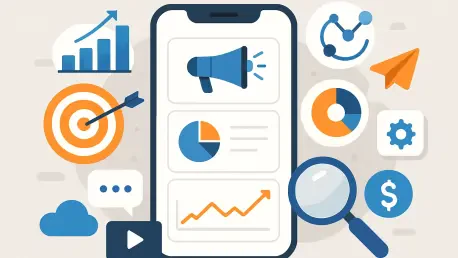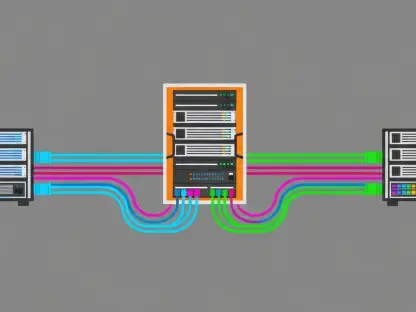In the ever-evolving world of mobile app advertising, navigating the iOS ecosystem has become a formidable challenge for marketers due to stringent privacy regulations and shifting user behaviors that demand innovative approaches. On August 14 of this year, Google announced a transformative set of tools aimed at enhancing the performance of iOS app campaigns, addressing these hurdles with a blend of creativity and technology. This development arrives at a pivotal moment, as App Store consumer spending has surged by an impressive 24% year-over-year, according to recent data from Appfigures, highlighting the critical need for effective user acquisition strategies. These new tools are not merely a stopgap measure but a strategic overhaul designed to empower advertisers, marketers, and developers operating within Apple’s privacy-centric framework. By introducing advanced ad formats, AI-driven optimization techniques, and privacy-compliant measurement solutions, Google is setting a bold new benchmark for success on iOS. The significance of these updates lies in their potential to bridge longstanding attribution gaps while aligning with the strict privacy standards that define the platform. This comprehensive approach promises to redefine how campaigns are managed, offering a glimpse into the future of mobile advertising where performance and user privacy coexist seamlessly.
Revolutionizing Engagement with New Ad Formats
Google’s latest enhancements for iOS app campaigns place a significant emphasis on expanding ad formats, particularly through the vast reach of YouTube, which engages 83% of global consumers daily. This strategic focus taps into a massive audience pool, with YouTube Shorts emerging as a particularly potent channel for reaching demographics that often bypass competing platforms like TikTok and Instagram Reels. Specifically, 45% of U.S. viewers on Shorts do not use TikTok, and 65% steer clear of Instagram Reels, presenting a unique opportunity for advertisers to connect with untapped segments. These short-form video ads are tailored to capture attention quickly, aligning with modern consumption habits that favor brief, impactful content. By integrating such formats into iOS campaigns, Google enables marketers to craft messages that resonate with users who might otherwise remain out of reach, enhancing the potential for app installs and sustained engagement in a highly competitive digital space.
Beyond YouTube Shorts, Google introduces co-branded partnership ads via the BrandConnect program, a novel approach that merges brand messaging with authentic creator content in in-feed and Shorts placements. This format leverages the power of influencer marketing, fostering trust through relatable and engaging narratives delivered by familiar faces. Additionally, playable ad formats, appearing as end cards after video content on select AdMob inventory, allow users to interact with an app before committing to a download, capitalizing on peak engagement moments. HTML5 playable assets further this interactive trend, adhering to strict technical limits like a 5MB ZIP file size and employing a cost-per-engagement (CPE) billing model that tracks conversions within a 30-day window. Together, these innovations offer advertisers diverse avenues to captivate iOS users, ensuring campaigns are not only visible but also memorable and actionable.
Harnessing AI for Smarter Campaign Optimization
Artificial Intelligence stands at the forefront of Google’s strategy to elevate iOS app campaigns, with the introduction of sophisticated bidding tools like Target Return on Ad Spend (ROAS) leading the charge. This AI-powered mechanism employs machine learning to forecast conversion values and dynamically adjust bids in real-time, aiming to maximize financial returns for advertisers. Early feedback from implementations, such as a 7% ROAS increase for Uatas, an Indonesian lending app, underscores the tangible benefits of this approach. Given the higher acquisition costs on iOS—often requiring bid multipliers of 1.5x compared to Android due to measurement constraints—this tool provides a critical edge in optimizing budget allocation. By focusing on value over volume, it addresses the unique financial dynamics of the iOS ecosystem, enabling marketers to achieve better outcomes without escalating expenditures unnecessarily.
Complementing the bidding strategies are additional AI-driven options like Maximize Conversions and Target Cost Per Action (tCPA), which cater to varied campaign objectives, whether prioritizing sheer install numbers or specific in-app behaviors. These systems automate bid management within predefined budget constraints, significantly reducing the manual workload for advertisers. Furthermore, AI extends its influence to creative optimization through video enhancement capabilities that adapt assets for diverse screen sizes and ad placements on YouTube. Utilizing dual models—one for reshaping videos into new aspect ratios and another for generative expansion—these tools eliminate the need for labor-intensive manual edits. This seamless adaptation ensures creative content remains relevant across formats, bolstering campaign efficiency in a landscape where data limitations often complicate iOS advertising efforts.
Prioritizing Privacy with Advanced Measurement Solutions
In response to the stringent privacy landscape shaped by Apple’s policies since iOS 14.5, Google has rolled out privacy-first measurement solutions that redefine how data is handled in iOS app campaigns. Central to this effort is on-device conversion measurement, a technology that processes app event data locally on users’ devices using de-identified information. This method ensures that no personal data leaves the device, aligning with Apple’s privacy mandates while still delivering actionable insights through device signals and timestamps. Such an approach mitigates the risk of privacy breaches, offering advertisers a secure way to track performance without compromising user trust. It represents a significant shift from traditional tracking methods, adapting to an environment where user anonymity is paramount and regulatory compliance is non-negotiable.
Enhancing this privacy-centric framework is Integrated Conversion Measurement (ICM), designed to improve attribution accuracy by synchronizing Google Ads data with third-party App Attribution Partner (AAP) reporting interfaces. This protocol minimizes discrepancies and provides real-time conversion tracking, as evidenced by remarkable results from Codeway, an AI app publisher, which saw a 6x increase in installs and an 80% reduction in cost per install after adopting ICM. Partnerships with AAPs like Adjust, AppsFlyer, and Kochava further standardize measurement, though platform-specific requirements—such as Firebase SDK 11.14.0 for iOS—add layers of complexity. In regions like the European Economic Area (EEA), explicit consent protocols complicate implementation, with iOS relying on tracking authorization methods. These tools collectively ensure compliance while maintaining campaign effectiveness, addressing the intricate balance between privacy and performance.
Adapting to Broader Industry Shifts
The mobile advertising sector is undergoing a profound transformation, largely driven by privacy regulations such as Apple’s App Tracking Transparency (ATT) framework, which has curtailed access to user-level data. This shift has rendered traditional attribution models increasingly obsolete, prompting industry leaders, including Google, to pivot toward privacy-preserving technologies like on-device measurement. Such solutions prioritize user anonymity while still enabling advertisers to glean critical insights, reflecting a consensus that privacy must be integral to modern advertising strategies. Google’s updates are not isolated but part of a larger movement where competitors are similarly adapting to ensure compliance without sacrificing campaign efficacy, signaling a new era where data protection shapes innovation.
Parallel to privacy concerns, the industry is witnessing a growing reliance on AI and automation to navigate the challenges of reduced data granularity. Google’s emphasis on tools like Target ROAS and automated video enhancements mirrors a broader trend toward value-based optimization, focusing on maximizing returns rather than chasing sheer volume. Additionally, the push for diverse ad formats—evident in YouTube Shorts, playable ads, and creator collaborations—responds to fragmented audience behaviors, where short-form and interactive content dominates engagement. These trends collectively indicate a dynamic future for mobile advertising, with Google positioning itself as a frontrunner by aligning its iOS campaign tools with evolving consumer preferences and regulatory demands, ensuring advertisers are equipped for sustained success.
Reflecting on Strategic Advancements
Looking back, Google’s announcement on August 14 marked a pivotal moment for iOS app campaigns, delivering a robust suite of tools that tackled the dual challenges of performance and privacy with remarkable foresight. The introduction of diverse ad formats, AI-driven optimization strategies, and privacy-compliant measurement solutions addressed critical pain points for advertisers navigating Apple’s ecosystem. Success stories, such as Uatas’ improved ROAS and Codeway’s dramatic install growth, underscored the real-world impact of these innovations. Moving forward, advertisers are encouraged to prioritize integration of these tools, focusing on technical readiness for SDK updates and consent protocols, especially in regulated regions. Exploring partnerships with creators for co-branded ads could further amplify engagement, while leveraging AI bidding strategies offers a path to sustained efficiency. As the mobile advertising landscape continues to evolve, staying adaptable to privacy trends and emerging formats will be key to maintaining a competitive edge, building on the strong foundation Google has laid with these enhancements.









